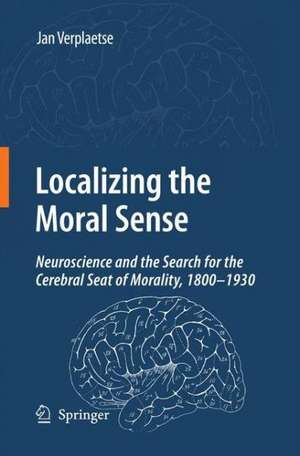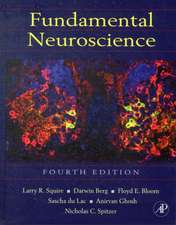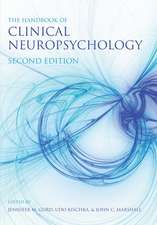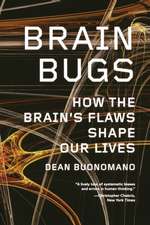Localizing the Moral Sense: Neuroscience and the Search for the Cerebral Seat of Morality, 1800-1930
Autor Jan Verplaetseen Limba Engleză Paperback – 12 sep 2014
How revolutionary this current research might be, the quest for a localisable ethical centre or moral organ is far from new. The moral brain was a recurrent theme in the works of neuroscientists during the 19th and 20th century. From the phrenology era to the encephalitis pandemic in the 1920s a wide range of European and American scientists (neurologists, psychiatrists, anthropologists and criminologists) speculated about and discussed the location of a moral sense in the human cortex. Encouraged by medical discoveries and concerned by terrifying phenomena like crime or “moral insanity” (psychopathy) even renowned and outstanding neurologists, including Moritz Benedikt, Paul Flechsig, Arthur Van Gehuchten, Oskar Vogt or Constantin von Monakow, had the nerve to make their speculations public. This book presents the first overview of believers and disbelievers in a cerebral seat of human morality, their positions and arguments and offers an explanation for these historical attempts to localise our moral sense, in spite of the massive disapproving commentary launched by colleagues.
| Toate formatele și edițiile | Preț | Express |
|---|---|---|
| Paperback (1) | 630.41 lei 6-8 săpt. | |
| SPRINGER NETHERLANDS – 12 sep 2014 | 630.41 lei 6-8 săpt. | |
| Hardback (1) | 636.69 lei 6-8 săpt. | |
| SPRINGER NETHERLANDS – 15 sep 2009 | 636.69 lei 6-8 săpt. |
Preț: 630.41 lei
Preț vechi: 741.66 lei
-15% Nou
Puncte Express: 946
Preț estimativ în valută:
120.68€ • 124.12$ • 100.12£
120.68€ • 124.12$ • 100.12£
Carte tipărită la comandă
Livrare economică 20 februarie-06 martie
Preluare comenzi: 021 569.72.76
Specificații
ISBN-13: 9789400791268
ISBN-10: 9400791267
Pagini: 312
Ilustrații: XX, 292 p.
Dimensiuni: 155 x 235 x 16 mm
Greutate: 0.44 kg
Ediția:2009
Editura: SPRINGER NETHERLANDS
Colecția Springer
Locul publicării:Dordrecht, Netherlands
ISBN-10: 9400791267
Pagini: 312
Ilustrații: XX, 292 p.
Dimensiuni: 155 x 235 x 16 mm
Greutate: 0.44 kg
Ediția:2009
Editura: SPRINGER NETHERLANDS
Colecția Springer
Locul publicării:Dordrecht, Netherlands
Public țintă
ResearchCuprins
The New Shapes of the Old Conscience.- Conscientiousness or the Moral Organ in Phrenology.- The Experimental Neurology of the Moral Centre.- The Clinical Neurology of the Moral Centre.- The Microscopy and Endocrinology of the Moral Centre.- The Localisation of Morality in Criminal Anthropology.- Moral Insanity as a Disorder of the Moral Sense.- Encephalitis Lethargica: A Brain Disease of the Moral Sense?.- Conclusion—Localising the Moral Sense: Believers and Disbelievers.
Recenzii
From the reviews:
“Verplaetse’s book begins with a long discussion of conscience and the moral sense through the eighteenth century. … Each chapter is filled with … detailed accounts of the views on the localization of higher faculties particularly related to the moral sense. … thus may be interest … to the specialist.” (Charles Gross, Social History of Medicine, Vol. 11 (3), September, 2010)
“Verplaetse’s book begins with a long discussion of conscience and the moral sense through the eighteenth century. … Each chapter is filled with … detailed accounts of the views on the localization of higher faculties particularly related to the moral sense. … thus may be interest … to the specialist.” (Charles Gross, Social History of Medicine, Vol. 11 (3), September, 2010)
Textul de pe ultima copertă
Due to the current revolution in brain research the search for the "moral brain" became a serious endeavour. Nowadays, neural circuits that are indispensable for moral and social behaviour are discovered and the brains of psychopaths and criminals - the classical anti-heroes of morality - are scanned with curiosity, even enthusiasm.
How revolutionary this current research might be, the quest for a localisable ethical centre or moral organ is far from new. The moral brain was a recurrent theme in the works of neuroscientists during the 19th and 20th century. From the phrenology era to the encephalitis pandemic in the 1920s a wide range of European and American scientists (neurologists, psychiatrists, anthropologists and criminologists) speculated about and discussed the location of a moral sense in the human cortex. Encouraged by medical discoveries and concerned by terrifying phenomena like crime or "moral insanity" (psychopathy) even renowned and outstanding neurologists, including Moritz Benedikt, Paul Flechsig, Arthur Van Gehuchten, Oskar Vogt or Constantin von Monakow, had the nerves to make their speculations public. This book presents the first overview of believers and disbelievers in a cerebral seat of human morality, their positions and arguments and offers an explanation for these historical attempts to localise our moral sense, in spite of the massive disapproving commentary launched by colleagues.
How revolutionary this current research might be, the quest for a localisable ethical centre or moral organ is far from new. The moral brain was a recurrent theme in the works of neuroscientists during the 19th and 20th century. From the phrenology era to the encephalitis pandemic in the 1920s a wide range of European and American scientists (neurologists, psychiatrists, anthropologists and criminologists) speculated about and discussed the location of a moral sense in the human cortex. Encouraged by medical discoveries and concerned by terrifying phenomena like crime or "moral insanity" (psychopathy) even renowned and outstanding neurologists, including Moritz Benedikt, Paul Flechsig, Arthur Van Gehuchten, Oskar Vogt or Constantin von Monakow, had the nerves to make their speculations public. This book presents the first overview of believers and disbelievers in a cerebral seat of human morality, their positions and arguments and offers an explanation for these historical attempts to localise our moral sense, in spite of the massive disapproving commentary launched by colleagues.
Caracteristici
First book on this topic Based on first-hand material (original medical publications in French, German, Italian and English) Well-written, depth and clarity















